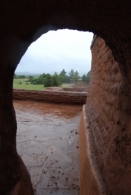Taos, NM
One thing the Chinese pride themselves on is how long their culture has been around. It has been continuous in some fashion for thousands of years. Although there are remnants of ancient civilizations in the U.S. you would be hard-pressed to find a place with an uninterrupted history and culture lasting more than 1,000 years. New Mexico is one of the rare exceptions.
I’ve been to New Mexico many times in my life either driving through or actually spending time there. However, I never really thought of it as a place to spend too much time. Recently, I made a trip to the Land of Enchantment for work, and now I want to go back and experience more.

After a successful stop in Taos to pick up new inventory from one of our artists, I went to downtown Taos to the plaza. Many of the cities established by the Spanish are set up around a plaza that was used for protection and commerce. Taos’ plaza or town square is a quaint little space with boutique shops and galleries around the perimeter.
I was getting hungry and found The Alley Cantina and had a delicious burger. As I left, I noticed that this establishment had won several awards, so I might suggest you get a bit to eat there. I tried to visit the Taos Pueblo, but arrived just after it closed. That gives a reason to go back!
Several other places caught my attention as I drove through Taos and the neighboring community. I did make a quick pit stop at the San Francisco de Assisi Mission Church in Ranchos de Taos. At our gallery, we welcomed a new artist this year who creates fantastic, brightly colored paintings of southwestern architecture. This mission is one of the buildings he has painted. We also have a wood sculpture of this historic structure from Roberto Cardinale in the gallery.
This 18th century adobe structure is a national historic landmark. It was closed when I stopped by, but the outside is worth it. I mean check out those buttresses!


Crossroads of History
New Mexico’s capitol, Santa Fe, is also full of history and culture. I spent the night there and explored the city the next day. Before my jaunt around Santa Fe’s downtown, I went up to Pecos National Historic Park. At the meeting place of the Southwest and the Great Plains, this was a strategic location for the pueblo communities of the region.
This site offers a fantastic view into history. At the top of a hill are the ruins of an ancient pueblo. A rich community where the pueblo communities would trade with plains tribes. Eventually, the Spanish made their way through on their fruitless search for the seven cities of gold that took them to Kansas. They described the Pecos community as the richest and most powerful they encountered. They wrote:
“It has the greatest and best buildings of these provinces and is most thickly settled … enclosed and protected by a wall and large houses, and by tiers of walkways which look out on the countryside. On these they keep their offensive and defensive arms: bows, arrows, shields, spears, and war clubs.”
 Now there are just low walls and mounds where the pueblo once thrived. The most impressive remnant is the ruin of the church. Of course, after the Spanish found it, they decided to colonize and proselytize. They forced the natives to build a mission at the end of their hill, and now its walls rise above the rest of the crumbling ruins.
Now there are just low walls and mounds where the pueblo once thrived. The most impressive remnant is the ruin of the church. Of course, after the Spanish found it, they decided to colonize and proselytize. They forced the natives to build a mission at the end of their hill, and now its walls rise above the rest of the crumbling ruins.
Unfortunately, after decades of strife and with a new Spanish city, Santa Fe, down the trail, the Pecos pueblo was eventually abandoned. By the time Americans came into the picture in the 1800s, Pecos was falling into ruin.
The NHP also includes a Civil War battlefield and historic cattle ranch. I spent the morning exploring the pueblo in the rain, so I didn’t really want to hike the battlefield trail for two hours and get wetter. But, then again, it gives another reason to go back!







Maureen
I’ve just recently found your blog, and really enjoyed all your posts on New Mexico. A great tribute to a lovely state that I’m happy to call home.
The Petrified Forest – a colorful depository of ancient lumber | Adventure Patches
[…] other sites I’ve visited, although not the most intact or elaborate (Pueblo Grande, Tuzigoot, Pecos). There is also a smaller ruin, Agate House, that was rebuilt in the 30s by the Civilian […]